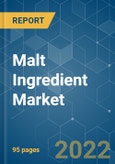The ongoing COVID-19 pandemic had some far-reaching effects on the economy. The Malt Ingredient market took the biggest hit on business, industries, and individual levels, being reported worldwide due to the supply chain obstructions and decline in the end-use products. However, with increasing demand for alcohol from emerging nations, increasing disposable income and dynamic consumption patterns are other elements predicted to assist the growth of the global malt ingredients market. Malt has been a primary source of the brewery for decades.
Barely is considered the primary source of malt ingredients. It is mainly used in the beverage industry, owing to its unique enzyme property. However, increasing demand for plant-based ingredients and natural sweeteners is expected to accelerate the growth of the global malt ingredient market. For instance, in 2020, Nestlé SA declared the launch of its version of plant-based cocoa malt Milo beverage in Australia. Nestle comes with this product as per consumer demand for plant-based drinks in their diets.
The beverage industry is a major consumer of malt ingredients, owing to an increase in alcoholic beverage demand, such as whisky, beer, vodka, scotch, and nonalcoholic beverages. Consumers worldwide are seeking distinctive and flavorful beers, pushing the market for malt ingredients in the beer market. The demand for the craft brewing and distilling industries has experienced significant growth during the past few years, which signifies the vast expansion of the global malt ingredient market.
Key Market Trends
Growing Popularity of Breweries Drives the Market Growth
The craft brewing and distilling industry demand has experienced significant growth during the past few years. Consumers worldwide are seeking distinctive and flavorful beers, pushing the market for malt ingredients in the beer market. In 2022, Bacardi silver is incorporated as the only alternative which consists of the rum flavor. The commodity was launched with enormous promotion on social media, television, radio, and other marketing campaigns. With the growing awareness of malt benefits, the scope it has tapped into the food industry as an additive, flavor, colorant, and ingredient. The rising trend of social gatherings, office parties, and hangouts with friends in pubs or bars has been increasing the consumption of beer and other alcoholic drinks, thus accelerating the growth of the malt ingredient market.
Europe Holds the Largest Share of the Market Share
Until the middle ages, nearly every malt grain was used for brewing in Germany. The breweries use the most popular raw malt ingredient, i.e., barley, followed by wheat. The country emphasizes the production and processing of malt ingredients to enhance its application base. To promote a healthy environment in raw materials, institutes like the Institutes for Brewing Technology in Berlin and Weihenstephan support breeding, cultivation, and processing that provides the superlative prerequisites for producing quality malting barley. Furthermore, Malteurop Group is an international group that anticipates the constantly evolving needs of the manufacturers by research and innovation by developing new barley varieties, new growing itineraries, new malts, and new growth areas for malting barley. Barley holds a 35% share in the regions of the European market of malt ingredients, followed by wheat. The rising consumption of non-alcoholic whisky, beer, and rum in malt beverages is boosting the growth of barley malt production in Europe.
Competitive Landscape
The malt ingredients market is highly fragmented, with various regional and global companies holding major market shares. The increasing applications of malt are attracting more players into the market. The brewing industry is the major area of application of malt ingredients. Players are also expanding their ingredient sources to enter into new applications. Some major players are Rahr Corporation, Vivescia (Malteurope), GrainCorp Limited, Axereal, and Group Soufflet. The manufacturer is majorly concentrating on enhancing their product quality by mergers and acquisitions and product innovations to obtain a competitive edge over other players in the market. Advanced distribution network and manufacturing expertise give an upper edge to the manufacturers to expand their range of products worldwide.
Additional Benefits:
- The market estimate (ME) sheet in Excel format
- 3 months of analyst support
This product will be delivered within 2 business days.
Table of Contents
Companies Mentioned (Partial List)
A selection of companies mentioned in this report includes, but is not limited to:
- Axereal
- Vivescia
- Rahr Corporation
- Group Soufflet
- Simpsons Malt Limited
- GrainCorp Limited
- Muntons PLC
- Puremalt Products Ltd
- Molson Coors Brewing Company
- Bacardi U.S.A. Inc.








